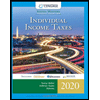
Loose Leaf for Principles of Taxation for Business and Investment Planning 2019 Edition
22nd Edition
ISBN: 9781260161472
Author: Sally Jones, Shelley C. Rhoades-Catanach
Publisher: McGraw-Hill Education
expand_more
expand_more
format_list_bulleted
Textbook Question
Chapter 17, Problem 2QPD
Discuss the tax policy reasons why gifts and inheritances aren’t included in gross income.
Expert Solution & Answer
Want to see the full answer?
Check out a sample textbook solution
Students have asked these similar questions
Which is not an objective of internal controls?A. Safeguard assetsB. Improve profitsC. Ensure accurate recordsD. Promote operational efficiencyneed help
Which is not an objective of internal controls?A. Safeguard assetsB. Improve profitsC. Ensure accurate recordsD. Promote operational efficiencyno ai
Can you solve this general accounting problem using appropriate accounting principles?
Chapter 17 Solutions
Loose Leaf for Principles of Taxation for Business and Investment Planning 2019 Edition
Ch. 17 - Prob. 1QPDCh. 17 - Discuss the tax policy reasons why gifts and...Ch. 17 - In what way does the tax law give preferential...Ch. 17 - Prob. 4QPDCh. 17 - A basic principle of federal tax law is that a...Ch. 17 - Prob. 6QPDCh. 17 - If an individual purchases property insurance on...Ch. 17 - Prob. 8QPDCh. 17 - Prob. 9QPDCh. 17 - Prob. 10QPD
Ch. 17 - Prob. 11QPDCh. 17 - Prob. 12QPDCh. 17 - Prob. 1APCh. 17 - Prob. 2APCh. 17 - Prob. 3APCh. 17 - Prob. 4APCh. 17 - Prob. 5APCh. 17 - Prob. 6APCh. 17 - Prob. 7APCh. 17 - Prob. 8APCh. 17 - Prob. 9APCh. 17 - Prob. 10APCh. 17 - Prob. 11APCh. 17 - Prob. 12APCh. 17 - Prob. 13APCh. 17 - Prob. 14APCh. 17 - Prob. 15APCh. 17 - Prob. 16APCh. 17 - Prob. 17APCh. 17 - Prob. 18APCh. 17 - Prob. 19APCh. 17 - Prob. 20APCh. 17 - Prob. 21APCh. 17 - Prob. 22APCh. 17 - Prob. 23APCh. 17 - Prob. 24APCh. 17 - Prob. 25APCh. 17 - Prob. 26APCh. 17 - Prob. 27APCh. 17 - Prob. 28APCh. 17 - Prob. 29APCh. 17 - Prob. 30APCh. 17 - Prob. 31APCh. 17 - Prob. 32APCh. 17 - Prob. 33APCh. 17 - Prob. 1IRPCh. 17 - Prob. 2IRPCh. 17 - Prob. 3IRPCh. 17 - Prob. 4IRPCh. 17 - Prob. 5IRPCh. 17 - Prob. 6IRPCh. 17 - Prob. 7IRPCh. 17 - Mrs. Newton, who is a self-employed author, paid...Ch. 17 - Prob. 9IRPCh. 17 - Prob. 10IRPCh. 17 - Prob. 11IRPCh. 17 - Prob. 12IRPCh. 17 - Prob. 13IRPCh. 17 - Prob. 14IRPCh. 17 - Prob. 15IRPCh. 17 - Prob. 16IRPCh. 17 - Prob. 1RPCh. 17 - Prob. 2RPCh. 17 - Prob. 3RPCh. 17 - Prob. 4RPCh. 17 - Prob. 5RPCh. 17 - Prob. 1TPCCh. 17 - Prob. 2TPCCh. 17 - Prob. 3TPCCh. 17 - Prob. 1CPCh. 17 - Prob. 2CPCh. 17 - Prob. 3CP
Knowledge Booster
Learn more about
Need a deep-dive on the concept behind this application? Look no further. Learn more about this topic, accounting and related others by exploring similar questions and additional content below.Similar questions
- Which is not an objective of internal controls?A. Safeguard assetsB. Improve profitsC. Ensure accurate recordsD. Promote operational efficiency no aiarrow_forwardPlease provide the accurate answer to this financial accounting problem using appropriate methods.arrow_forwardI am searching for the accurate solution to this financial accounting problem with the right approach.arrow_forward
- 20 Nelson and Murdock, a law firm, sells $8,000,000 of four-year, 8% bonds priced to yield 6.6%. The bonds are dated January 1, 2026, but due to some regulatory hurdles are not issued until March 1, 2026. Interest is payable on January 1 and July 1 each year. The bonds sell for $8,388,175 plus accrued interest. In mid-June, Nelson and Murdock earns an unusually large fee of $11,000,000 for one of its cases. They use part of the proceeds to buy back the bonds in the open market on July 1, 2026 after the interest payment has been made. Nelson and Murdock pays a total of $8,456,234 to reacquire the bonds and retires them. Required1. The issuance of the bonds—assume that Nelson and Murdock has adopted a policy of crediting interest expense for the accrued interest on the date of sale.2. Payment of interest and related amortization on July 1, 2026.3. Reacquisition and retirement of the bonds.arrow_forward13 Which of the following is correct about the difference between basic earnings per share (EPS) and diluted earnings per share? Question 13 options: Basic EPS uses comprehensive income in its calculation, whereas diluted EPS does not. Basic EPS is not a required disclosure, whereas diluted EPS is required disclosure. Basic EPS uses total common shares outstanding, whereas diluted EPS uses the weighted-average number of common shares. Basic EPS is not adjusted for the potential dilutive effects of complex financial structures, whereas diluted EPS is adjusted.arrow_forwardPlease explain the solution to this general accounting problem with accurate explanations.arrow_forward
- I need guidance with this financial accounting problem using the right financial principles.arrow_forwardGeneral Accounting Question Solutionarrow_forwardWhich is not an objective of internal controls?A. Safeguard assetsB. Improve profitsC. Ensure accurate recordsD. Promote operational efficiencyarrow_forward
arrow_back_ios
SEE MORE QUESTIONS
arrow_forward_ios
Recommended textbooks for you
 Intermediate Accounting: Reporting And AnalysisAccountingISBN:9781337788281Author:James M. Wahlen, Jefferson P. Jones, Donald PagachPublisher:Cengage Learning
Intermediate Accounting: Reporting And AnalysisAccountingISBN:9781337788281Author:James M. Wahlen, Jefferson P. Jones, Donald PagachPublisher:Cengage Learning Individual Income TaxesAccountingISBN:9780357109731Author:HoffmanPublisher:CENGAGE LEARNING - CONSIGNMENT
Individual Income TaxesAccountingISBN:9780357109731Author:HoffmanPublisher:CENGAGE LEARNING - CONSIGNMENT


Intermediate Accounting: Reporting And Analysis
Accounting
ISBN:9781337788281
Author:James M. Wahlen, Jefferson P. Jones, Donald Pagach
Publisher:Cengage Learning

Individual Income Taxes
Accounting
ISBN:9780357109731
Author:Hoffman
Publisher:CENGAGE LEARNING - CONSIGNMENT



The Basics of Tax Preparation; Author: Roosevelt University;https://www.youtube.com/watch?v=EJpTwf9b82M;License: Standard Youtube License